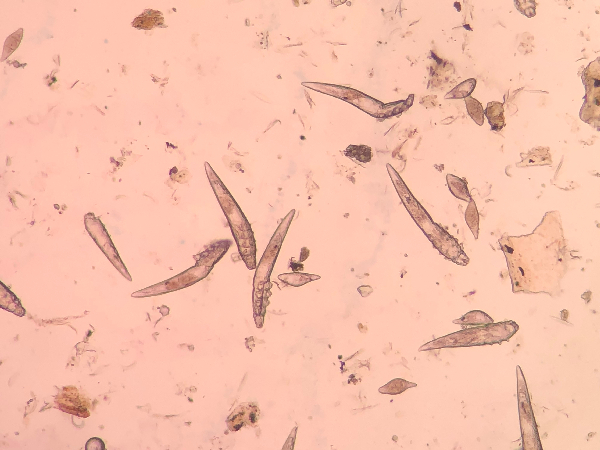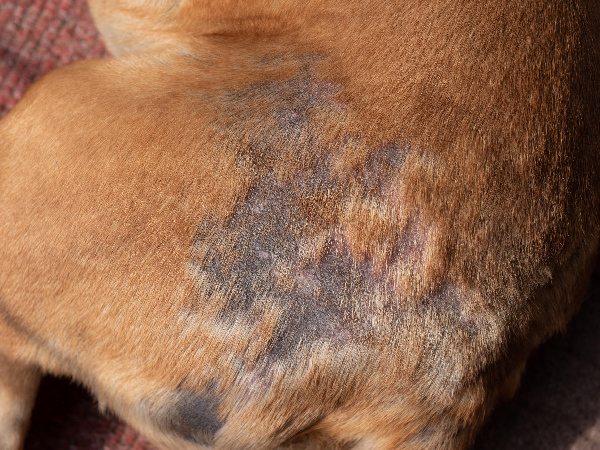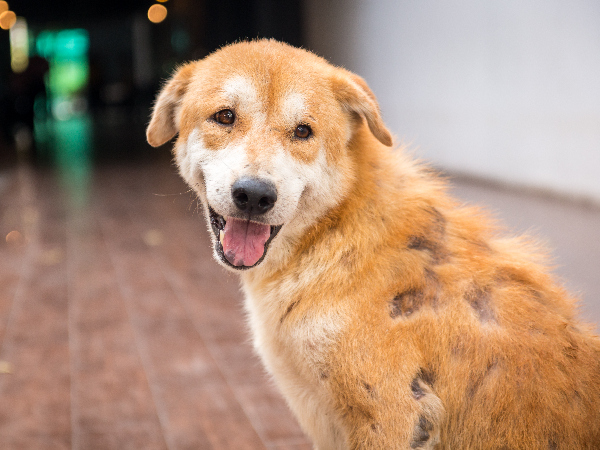What do dog mites look like and how to get rid of them
Dog mites are tiny creatures with a hard exoskeleton (protective structure on the outside of their body) that can infest your dog's skin and cause skin diseases and irritation.
They look like tiny black dots on the skin to the naked eye. Symptoms include itching, hair loss, redness and inflammation. Mites in dogs can be treated by topical ointments or oral medications prescribed by your vet.
Brief summary…
- Mites are tiny parasites that can infest a dog's skin, ears or fur and cause irritation and inflammation
- Four main species of mites can affect dogs: Demodex, Sarcoptes, Cheyletiella, and Otodectes
- Symptoms include itching, hair loss, scabs and open sores, redness and inflammation
- They can cause various health problems, including skin irritation, skin infections, ear infections, allergic reactions, and reduced quality of life.
- Preventative measures for mites include preventative medication, regular grooming, a healthy diet, and maintaining a clean environment
- Pets on preventative healthcare plans such as Pet Health Club receive anti-parasitic treatments as part of their membership
What are dog mites?
Mites are tiny parasites, typically smaller than a human hair, that can infest a dog's skin, ears or fur and cause irritation and inflammation. They are part of the arachnid family, the same family that ticks and spiders belong to. Four main species of mites can affect dogs.
Types of mites on dogs
Demodex mites
These mites live naturally on your dog's skin without causing a problem, but if their immune system is altered, they can multiply too quickly and cause skin problems. Demodicosis can occur in young dogs (3-18 months) due to a defect in the immune system, or in older dogs with an immune system weakened by disease.

Sarcoptes mites
These highly contagious mites cause sarcoptic mange. Mange is a very itchy and uncomfortable skin condition and can spread to other dogs and humans. It is often seen in malnourished or stray dogs, and in wild fox populations.
Cheyletiella mites
These are often called "walking dandruff" because they cause excessive scale and dandruff, and due to the appearance of the large, white mites moving around on the skin. Affected dogs may be itchy.
Otodectes mites
These infest a dog's ears and can cause intense itching, head shaking, and ear inflammation.
Not all mites cause problems for dogs. However, if you suspect your dog has a mite infestation, you must speak to your vet to decide on the best steps.
Symptoms of dog mites
The symptoms of mites depends on the type and how bad the infestation is, but common symptoms typically include the following:
- Itching
- Hair loss
- Scabs and open sores
- Redness and inflammation
- Dandruff or flaking skin
- Ear discharge and odour
Some dogs may not show any symptoms, especially in the early stages of infestation.

How do dogs get mites?
Mites, like fleas, can be passed from dog to dog through close contact. This could be when they are playing together, sleeping next to each other or if they have been at doggy daycare or boarding kennels. They can also be passed indirectly from dog to dog through feeding bowls, bedding and toys. The exception is Demodex mites, which are passed from mother to pup soon after birth and are then not contagious between adult dogs.
What causes dog mites?
The causes of mites depend on the type of mite. Some common causes include:
- Weakened immune system: Demodex mites, usually present on a dog's skin, can overgrow and cause skin problems when a dog's immune system weakens.
- Direct contact with an infected animal: Sarcopes, Cheyletiella and Otodectesmites are highly contagious and can be transmitted from one dog to another through direct contact.
- The dog's environment: Walking dandruff mites can be transmitted through contaminated bedding, furniture, or carpets.
Some dogs may be more prone to mite infestations due to underlying health conditions, stress, or other factors such as malnutrition. Because mites can be passed on indirectly, keeping your dog's environment clean is essential.
What do dog mites cause?
Mites in dogs can cause various health problems, depending on the mite type and the infestation's severity. Some common health problems caused by mites in dogs include:
Skin irritation
Mites can cause skin irritation, including itching, redness, inflammation, and hair loss.
Skin infections
Scratching and biting at the affected areas can lead to secondary skin infections, which can cause further discomfort and require treatment with antibiotics or other medications.

Ear infections
Otodectes mites infest a dog's ears and can cause intense itching, inflammation, and ear canal infections.
Allergic reactions
Some dogs may be allergic to mites, which can cause additional symptoms such as hives, swelling, and respiratory problems.
Reduced quality of life
Severe mite infestations can cause dogs to feel uncomfortable, lethargic, and less interested in food or play.
When should I see my vet?
If you notice your dog scratching more than usual or notice changes to the skin such as hair loss, redness, sores or excess dandruff, you should visit your vet as soon as possible. The issues caused by mites in dogs are easier to treat with early detection. Pets on preventative healthcare plans such as Pet Health Club receive anti-parasitic treatments as part of their membership.
Mite treatment for dogs
Mites are diagnosed through a combination of a physical examination, skin scrapings, and other tests.
Physical examination:
Your vet will thoroughly examine your dog, checking for signs of skin irritation, hair loss, and other symptoms of mite infestations.
Skin scrapings:
Mites are very tiny, so your vet may take a sample of your dog's skin cells or fur to examine under a microscope. They can then identify the type of mite and the severity of the infestation.
Skin biopsy:
Sometimes, your vet may recommend a skin biopsy to examine the affected area further and rule out other skin conditions.
Blood tests:
Your veterinarian may recommend blood tests to check for underlying health conditions contributing to your dog's symptoms.
Once a diagnosis of mites is made, your vet will come up with a treatment plan based on the type of mite and the severity of the infestation. Mite treatment in dogs may include topical or oral medications, shampoos, or antibiotics to treat secondary infections. The mite life cycle is typically a few weeks long, and multiple treatments may be needed to fully resolve the problem.
How to get rid of mites on dogs
There are lots of ways to help your dog stay free of mites.
Grooming
Grooming is essential for your dog. Keeping your dog clean and well groomed will not only help rid them of parasites but will also keep their coat clean and soft, allow you to check for any cuts, scrapes, lumps or bumps and provide a way to bond with your dog.
Washing your dog should only really happen when they are particularly dirty or have rolled in something disgusting, or under the direction of a vet for certain skin conditions. Always use a dog-specific shampoo, as human (especially baby) shampoos can be unsuitable for dogs’ skin.
Keeping your dog's ears clean is incredibly important. Check them regularly and wipe them with a wet cloth to clean them out. You should only clean the visible outer portion of the ear: never poke anything down the ear canal, including cotton buds. If your dog is shaking their head or pawing at their ears, see your vet; they can flush their ears and thoroughly clean them out.

Healthy diet
A healthy diet will help keep their coat and skin in great shape and make them an unattractive place for mites to live. Your dog's diet should include proteins, fats and carbs in balanced proportion, as well as micronutrients such as vitamins and minerals. Speak to your vet for more advice on the best diet for your dog.
Clean environment
Clean bedding will help prevent mites from spreading indirectly. Keep your home clean and well-ventilated, avoid taking your dog to unclean places and don't let them interact with dogs with open sores or areas of fur missing, as they may suffer from mites or mange and could quickly infest your dog. Keep wildlife such as foxes out of gardens where possible.
Common questions about mites
What do dog mites look like?
Cheyletiella mites, though appearing as tiny black dots on the skin, are actually white and a tad larger than they seem. Under a microscope, their true form comes to light, showing a blend of a tick and a spider. As these mites are hard to spot with the naked eye, it's important to keep a close watch on your dog's behaviour and the condition of their skin.
What happens if dog mites go untreated?
While mites aren't fatal, if left untreated, they can lead to severe skin changes, which can cause discomfort, pain and distress.. If you think your dog has mites, then seek veterinary attention.
Can dog mites jump onto humans?
Humans can catch sarcoptic mites from dogs. They can cause skin irritation in humans, which is usually self-limiting as the mite can't complete their life cycle on human skin. It can be treated with ointments and creams. Uncommonly, Cheyletiella and Otodectes mites can also be passed to humans.
Need more info?
If you’ve any questions about protecting your puppy or dog, just call or visit your local vet.
Find your nearest vet using our Find a Vet page, or speak to a vet online using Online Vets.




